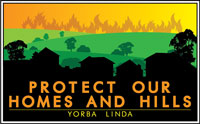latimes.com
Buildings on steep slopes, in Santa Ana wind corridors and in low-density developments mixed with wild lands were most likely to have burned in the last decade.
By Bettina Boxall, Los Angeles Times
June 16, 2012
The expression “location, location, location” doesn’t apply just to buying real estate; it can also determine whether a house burns down in a wildfire.
Researchers who studied data on more than 5,500 buildings damaged or destroyed in Southern California fires during the last decade found the most vulnerable structures were in certain places and certain arrangements.
The results, recently published in the online journal PlosOne.org, have important implications for wildfire protection policies in the Southland, which focus on brush clearance and fireproof construction. That is not enough, say the authors, who argue there are some places where homes simply shouldn’t be built.
“We’re finding that geography is most important—where is the house located and where are [houses] placed on the landscape,” said the paper’s lead author, research scientist Alexandra Syphard of the Conservation Biology Institute.
Syphard and her coauthors from the U.S. Geological Survey and the University of Wisconsin gathered data on 700,000 addresses in the Santa Monica Mountains and part of San Diego County. They then mapped the structures that had burned in those areas between 2001 and 2010, a time of devastating wildfires in the region.
Buildings on steep slopes, in Santa Ana wind corridors and in low-density developments intermingled with wild lands were the most likely to have burned. Nearby vegetation was not a big factor in home destruction.
“If you want to predict whether or not a home will be lost in a fire, going out and looking at the surrounding fuels is not going to tell you nearly as much as looking at the location and the frequency of fires in that location in the past,” said coauthor Jon Keeley, a USGS research scientist and chaparral expert.
Comparing the state’s fire hazard maps with their own results, the researchers also concluded that on a local community scale, the state maps were not very good at identifying the most vulnerable areas.
The state maps estimate fire risk based on wild land fuel distribution, assuming that the denser and older the brush, the greater the threat. Because most of the Santa Monicas are covered with coastal scrub and chaparral, the state maps put most of the range in the medium- or high-risk category.
But during the study period, home loss was concentrated in only a portion of the Santa Monicas: in the Malibu area, which sits in the path of hot, dry Santa Ana winds that carry embers for miles.
Looking at vegetation growing within roughly half a mile of structures, the authors concluded that the exotic grasses that often sprout in areas cleared of brush could be more of a fire hazard than the brush. “We ironically found that homes that were surrounded mostly by grass actually ended up burning more than homes with higher fuel volumes like shrubs,” Syphard said.
Dry grasses ignite quickly and flames race through them, easily outrunning attempts to contain them. Firefighters have seen “greater structure loss and greater loss of life from the flashy grass fires,” said Los Angeles County Deputy Fire Chief John Todd, adding that it was critical for residents to cut back neighboring grasslands.
Along with geography, historic wildfire frequency was a harbinger of future destruction. Areas that had burned most frequently between 1910 and 2000 were the ones most likely to have lost buildings in the past decade. “There are certain fire corridors where we repeatedly get fires,” Keeley said. “If you’re in an environment that historically had a lot of fire, today you’re much more vulnerable.”
Land use planners and the firefighting community should be taking such factors into account, the researchers argue. Just as there are flood zones where construction is restricted, there should be fire zones designated where development is discouraged through insurance and tax policies and local planning guidelines.
“It’s the most difficult thing to achieve, but it could result in the most significant protection,” Syphard said, acknowledging the political sensitivity of that approach.
L.A. County planners have begun to take fire hazard into consideration. In 2004, the county adopted an ordinance setting certain ridgelines off limits for home construction because of the fire danger. But most county regulations deal with building standards or siting on a parcel, such as prohibiting open eaves or discouraging long driveways that hinder firefighter access.
Private parcels were laid out long ago in the Santa Monicas, limiting what the county can do in terms of clustering development or keeping it out of wind corridors, said Gina Natoli, a supervising regional planner for the county. “The pattern has been set.”
Fire-prone spots are often the most popular home sites. “In the Santa Monica Mountains, they want to have their home on the edge of the cliff so they can have a better view of the ocean,” Todd said. “It’s going to reduce the survivability of your home.”
bettina.boxall@latimes.com latimes.com/news/local/la-me-wildfire-houses-20120616,0,4730156.story
